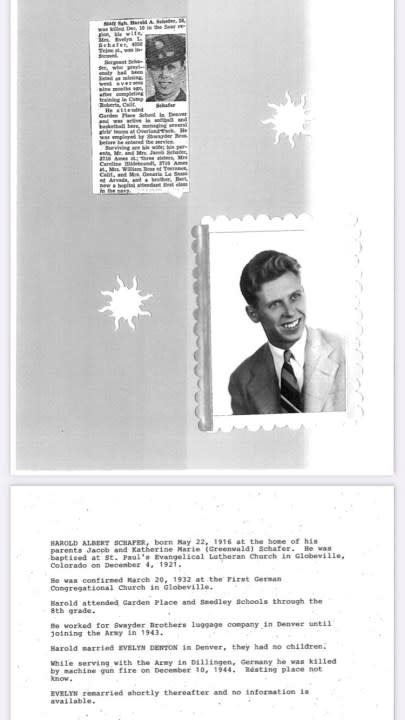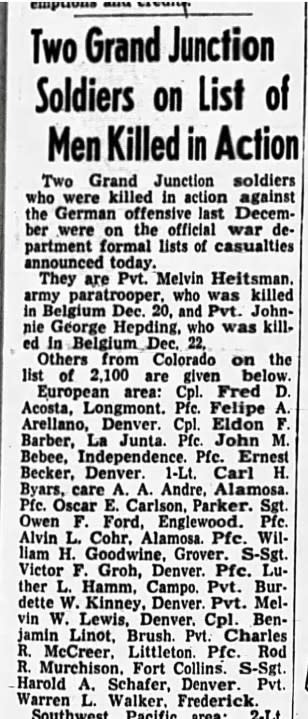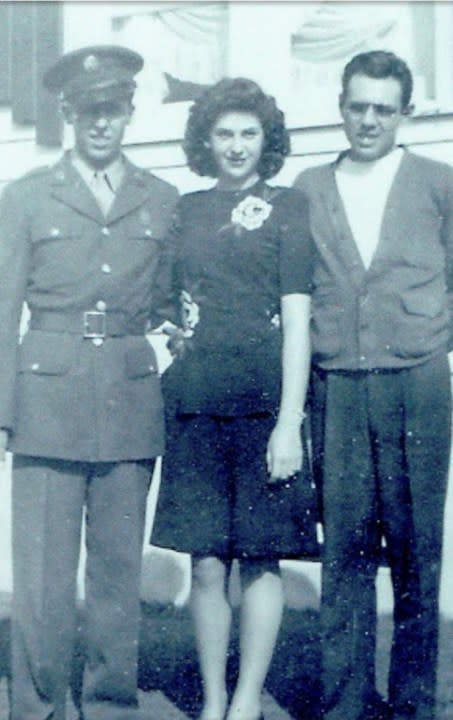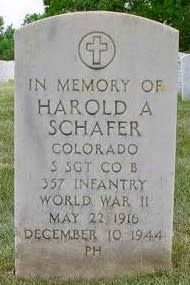Denver WWII soldier identified 80 years after he was killed in action

DENVER (KDVR) — The remains of a World War II soldier from Denver were finally identified nearly 80 years after his death, the Defense POW/MIA Accounting Agency announced Thursday.
Staff Sergeant Harold A. Schafer was 28 years old when he was killed in action during WWII. He was considered non-recoverable until he was accounted for on Sept. 26 last year.
Colorado WWII POW soldier identified over 80 years after death
Schafer joined the Army in 1943 was assigned to Company B, 1st Battalion, 357th Infantry Regiment, 90th Infantry Division in December of 1944, according to the DPAA.
His battalion crossed the Saar River on Dec. 6, 1944, and had secured a wooded high ground north of Dillingen, Germany, but the battalion was stopped by German resistance, the DPAA said in a release.
For several days, Schafer’s battalion was defensive on the hill against numerous enemy counterattacks. On Dec. 10, 1944, according to the DPAA, Schafer was moving to a different fighting position when he was struck and killed by enemy machinegun fire.
American forces were ordered to withdraw from the area on Dec. 21, but due to the intense fighting, Schafer’s body was among many that could not be recovered.
Staff Sergeant Harold A. Schafer was 28 years old when he was killed in action during WWII. He was considered non-recoverable until he was accounted for by the Defense POW/MIA Accounting Agency on Sept. 26, 2023. (Photo: Defense POW/MIA Accounting Agency) Staff Sergeant Harold A. Schafer was 28 years old when he was killed in action during WWII. He was considered non-recoverable until he was accounted for by the Defense POW/MIA Accounting Agency on Sept. 26, 2023. (Photo: Defense POW/MIA Accounting Agency) Staff Sergeant Harold A. Schafer was 28 years old when he was killed in action during WWII. He was considered non-recoverable until he was accounted for by the Defense POW/MIA Accounting Agency on Sept. 26, 2023. (Photo: Defense POW/MIA Accounting Agency) Staff Sergeant Harold A. Schafer was 28 years old when he was killed in action during WWII. He was considered non-recoverable until he was accounted for by the Defense POW/MIA Accounting Agency on Sept. 26, 2023. (Photo: Defense POW/MIA Accounting Agency) Staff Sergeant Harold A. Schafer was 28 years old when he was killed in action during WWII. He was considered non-recoverable until he was accounted for by the Defense POW/MIA Accounting Agency on Sept. 26, 2023. (Photo: Defense POW/MIA Accounting Agency)
Colorado WWII soldier’s remains finally identified after nearly 80 years
How SSG Schafer’s body was recovered, identified
Between 1946 and 1950, the American Graves Registration Command investigated areas of Europe, including the Dillingen area, to recover missing American personnel. Schafer’s remains were not found, and he was officially declared non-recoverable in Nov. 1951.
Fast forward to 2018, a DPAA historian was studying missing soldiers who were lost during the fighting at Dillingen. The historian determined that Schafer might be associated with a set of remains designated “X-4651 St. Avpold,” which were recovered from the Dillingen area by AGRC investigators in 1946.
Schafer’s remains were exhumed from Normandy American Cemetery in Colleville-sur-Mer, France, in Aug. 2021 by the Department of Defense and the American Battle Monuments Commission, the DPAA said.
Then, his remains were sent to a DPAA lab where scientists used anthropological analysts, dental and circumstantial evidence as well as mitochondrial DNA analysis to identify the remains as Schafer’s.
FOX31 Newsletters: Sign up to get breaking news sent to your inbox
Today, his name is among many written on the Walls of the Missing at Lorraine American Cemetery in St. Avold, France. Now that he has been found and identified, a rosette will be placed next to his name on the wall.
SSG Schafer will be buried in Wheat Ridge on a date that is to be determined. The DPAA noted that his family recently got a full briefing on his identification, which is why the information was not released until now.
For the latest news, weather, sports, and streaming video, head to FOX31 Denver.






